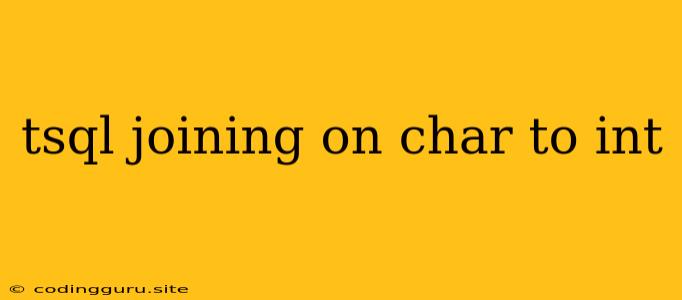T-SQL Joining on CHAR to INT: Bridging the Type Gap
In the realm of SQL database operations, joining tables is a fundamental task. But what happens when the columns you want to join on have different data types? This often occurs when one column is a CHAR (character) type and the other is an INT (integer). This scenario presents a challenge, as SQL doesn't automatically convert between these two data types during a join. Fear not, this article will guide you through the process of successfully joining tables with CHAR and INT columns using T-SQL.
Why Does This Matter?
You might encounter this scenario when dealing with legacy databases or when data has been entered in inconsistent formats. For instance, you may have a Customer table with a Customer ID column stored as CHAR and an Orders table with an Order ID column stored as INT. To analyze customer orders efficiently, you need to join these tables based on their respective ID columns.
The Challenge: Direct Join
A direct join attempt like this would fail:
SELECT *
FROM Customer c
JOIN Orders o ON c.CustomerID = o.OrderID;
T-SQL would throw an error because it cannot implicitly convert CHAR to INT.
Solutions: Explicit Conversion
To resolve this issue, we need to explicitly convert the CHAR column to INT before joining. Here are three effective approaches:
1. Using the CAST Function:
SELECT *
FROM Customer c
JOIN Orders o ON CAST(c.CustomerID AS INT) = o.OrderID;
The CAST function converts the CHAR value to an INT value.
2. Using the CONVERT Function:
SELECT *
FROM Customer c
JOIN Orders o ON CONVERT(INT, c.CustomerID) = o.OrderID;
The CONVERT function offers more control, allowing you to specify the target data type and format. In this case, we use the INT data type to convert the CHAR column.
3. Using the TRY_CONVERT Function:
SELECT *
FROM Customer c
JOIN Orders o ON TRY_CONVERT(INT, c.CustomerID) = o.OrderID;
TRY_CONVERT is useful when you aren't certain that all values in the CHAR column can be successfully converted to INT. If conversion fails, TRY_CONVERT returns NULL instead of an error, which can be helpful for handling potential data inconsistencies.
4. Using the ISNUMERIC Function:
SELECT *
FROM Customer c
JOIN Orders o ON ISNUMERIC(c.CustomerID) = 1 AND CAST(c.CustomerID AS INT) = o.OrderID;
This approach is useful for ensuring that the value in the CHAR column is truly numeric before converting it to INT. The ISNUMERIC function returns 1 if the value is numeric, 0 otherwise.
Best Practices
- Always validate the data: Before performing conversion, ensure the CHAR column contains valid numeric values. Use the ISNUMERIC function or a
WHEREclause with a regular expression to check the data. - Handle invalid data: If you encounter invalid data, consider alternative approaches to include it in the join, such as using
LEFT JOINor adding aCASEstatement to handle non-numeric values. - Choose the right conversion function: The CAST and CONVERT functions have slightly different functionalities. Choose the one that best suits your needs.
- Performance considerations: Converting data types can impact performance, especially with large datasets. Test your conversion methods to ensure they don't create significant performance overhead.
Example Scenario
Let's say you have a Customer table with a Customer ID column stored as CHAR and an Orders table with an Order ID column stored as INT. You want to retrieve all customer information along with their orders.
-- Create sample tables
CREATE TABLE Customer (
CustomerID CHAR(10),
CustomerName VARCHAR(50)
);
CREATE TABLE Orders (
OrderID INT,
CustomerID INT,
ProductName VARCHAR(50)
);
-- Insert sample data
INSERT INTO Customer (CustomerID, CustomerName) VALUES
('1001', 'John Doe'),
('1002', 'Jane Smith');
INSERT INTO Orders (OrderID, CustomerID, ProductName) VALUES
(1, 1001, 'Laptop'),
(2, 1002, 'Tablet');
-- Join tables with conversion
SELECT c.CustomerName, o.ProductName
FROM Customer c
JOIN Orders o ON CAST(c.CustomerID AS INT) = o.CustomerID;
-- Output
CustomerName ProductName
John Doe Laptop
Jane Smith Tablet
Conclusion
Joining tables with different data types, especially CHAR and INT, requires explicit conversion. By leveraging the CAST, CONVERT, or TRY_CONVERT functions, you can successfully bridge the type gap and perform efficient joins in your T-SQL queries. Always validate the data, handle invalid values appropriately, and choose the conversion method that best suits your needs and performance requirements.
